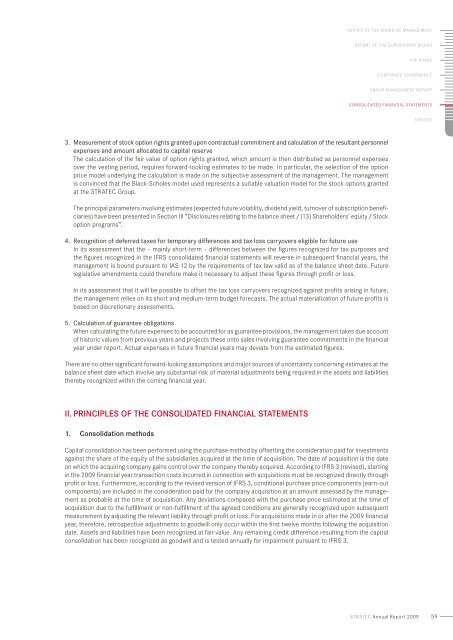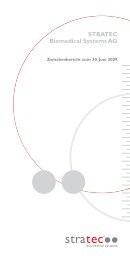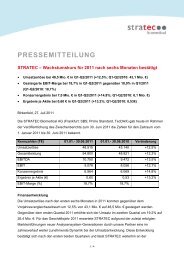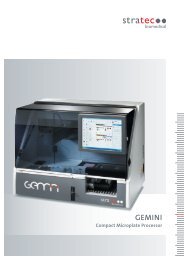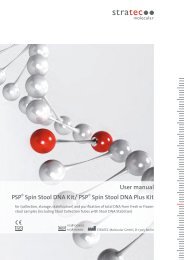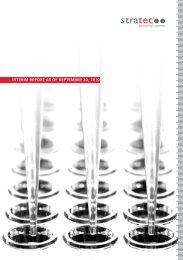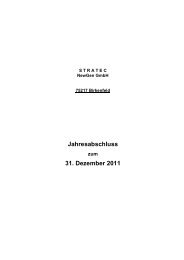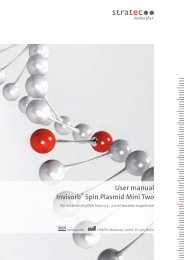annual Report 2009 - STRATEC Biomedical AG
annual Report 2009 - STRATEC Biomedical AG
annual Report 2009 - STRATEC Biomedical AG
Create successful ePaper yourself
Turn your PDF publications into a flip-book with our unique Google optimized e-Paper software.
<strong>Report</strong> of the board of Management<br />
<strong>Report</strong> of the supervisory board<br />
THE share<br />
Corporate Governance<br />
Group Management report<br />
Consolidated financial statements<br />
Service<br />
3. Measurement of stock option rights granted upon contractual commitment and calculation of the resultant personnel<br />
expenses and amount allocated to capital reserve<br />
the calculation of the fair value of option rights granted, which amount is then distributed as personnel expenses<br />
over the vesting period, requires forward-looking estimates to be made. In particular, the selection of the option<br />
price model underlying the calculation is made on the subjective assessment of the management. The management<br />
is convinced that the Black-Scholes model used represents a suitable valuation model for the stock options granted<br />
at the <strong>STRATEC</strong> Group.<br />
the principal parameters involving estimates (expected future volatility, dividend yield, turnover of subscription beneficiaries)<br />
have been presented in Section III “Disclosures relating to the balance sheet / (13) Shareholders’ equity / Stock<br />
option programs”.<br />
4. Recognition of deferred taxes for temporary differences and tax loss carryovers eligible for future use<br />
in its assessment that the – mainly short-term – differences between the figures recognized for tax purposes and<br />
the figures recognized in the IFRS consolidated financial statements will reverse in subsequent financial years, the<br />
management is bound pursuant to IAS 12 by the requirements of tax law valid as of the balance sheet date. Future<br />
legislative amendments could therefore make it necessary to adjust these figures through profit or loss.<br />
in its assessment that it will be possible to offset the tax loss carryovers recognized against profits arising in future,<br />
the management relies on its short and medium-term budget forecasts. The actual materialization of future profits is<br />
based on discretionary assessments.<br />
5. Calculation of guarantee obligations<br />
When calculating the future expenses to be accounted for as guarantee provisions, the management takes due account<br />
of historic values from previous years and projects these onto sales involving guarantee commitments in the financial<br />
year under report. Actual expenses in future financial years may deviate from the estimated figures.<br />
There are no other significant forward-looking assumptions and major sources of uncertainty concerning estimates at the<br />
balance sheet date which involve any substantial risk of material adjustments being required in the assets and liabilities<br />
thereby recognized within the coming financial year.<br />
II. Principles of the consolidated financial statements<br />
1. Consolidation methods<br />
Capital consolidation has been performed using the purchase method by offsetting the consideration paid for investments<br />
against the share of the equity of the subsidiaries acquired at the time of acquisition. The date of acquisition is the date<br />
on which the acquiring company gains control over the company thereby acquired. According to IFRS 3 (revised), starting<br />
in the <strong>2009</strong> financial year transaction costs incurred in connection with acquisitions must be recognized directly through<br />
profit or loss. Furthermore, according to the revised version of IFRS 3, conditional purchase price components (earn-out<br />
components) are included in the consideration paid for the company acquisition at an amount assessed by the management<br />
as probable at the time of acquisition. Any deviations compared with the purchase price estimated at the time of<br />
acquisition due to the fulfillment or non-fulfillment of the agreed conditions are generally recognized upon subsequent<br />
measurement by adjusting the relevant liability through profit or loss. For acquisitions made in or after the <strong>2009</strong> financial<br />
year, therefore, retrospective adjustments to goodwill only occur within the first twelve months following the acquisition<br />
date. Assets and liabilities have been recognized at fair value. Any remaining credit difference resulting from the capital<br />
consolidation has been recognized as goodwill and is tested <strong>annual</strong>ly for impairment pursuant to IFRS 3.<br />
stratec Annual <strong>Report</strong> <strong>2009</strong><br />
59


